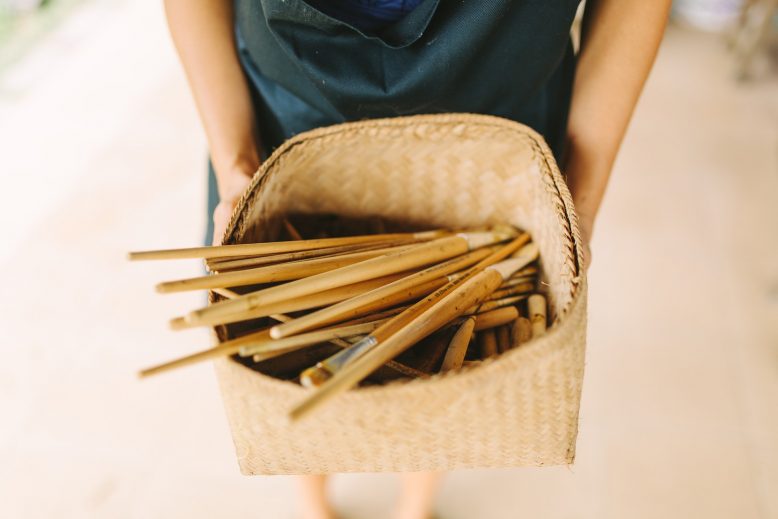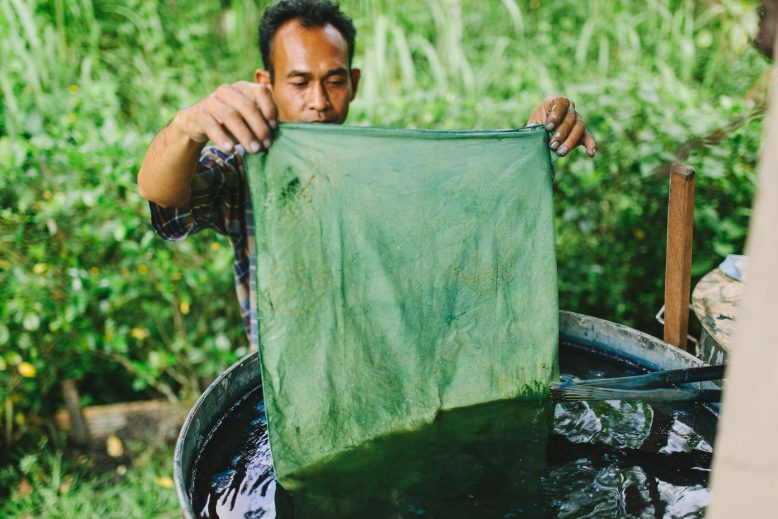One technique that I’ve always been drawn to is Indigo Dyeing – those bright blue hues that are present in so many different traditional cultures around the world. Knowing that Indigo Dyeing is a traditional technique in Bali, I was itching to learn more about it as part of our recent Creative Escape.
After a little bit of research I discovered an amazing organisation called Threads of Life, a fair trade business that works with thousands of women across Indonesia to recover and reteach traditional techniques (like indigo dyeing and weaving) and help these women to build businesses and their livelihoods. Although Threads of Life offer many different classes such as weaving and all different forms of traditional dying, I was particularly interested in learning about Balinese Indigo Dyeing – as I have a serious addiction to indigo fabrics! Nicola and I went along and our class gave us an eye opening lesson into the flora, dye processes and practice of Indonesia’s Indigo Dyeing, some of which I wanted to share with you guys!
- The beauty in simplicity.
- Indigo Plants
How Traditional Indigo Dying Is Done
I’ve done a little bit of dyeing in the past, usually with packet dyes, salt and boiling water and (other than a few fails) I’ve enjoyed the transformational process of dipping fabric in colour. So that’s kind of what I was expecting, if I’m honest. But it turns out that Indigo Dyeing is completely different in that, done using the traditional process, it’s 100% natural and often organic. Instead of using heat and a mordant (i.e. a fixer) it is done using a living fermentation process that naturally sets the dye into the textile. This came as a huge surprise to me… Fermented foods are something I’ve been getting into in the last few years, and to hear that traditional indigo dyeing is similar to making sourdough starter or yogurt absolutely blew my mind! Read on for some of what I learnt in our class.
1. Growing & Harvesting the Indigo Plant
Indigo dye is derived from the shrubs Indigofera Tinctoria and Suffruticosa, plants that have long been grown for the purpose of making dyes. The dye can be extracted from either the leaves or the roots, but for the purposes of sustainability the dye from the leaves is what Threads of Life uses. Leaves are harvested from the trees, usually during the wet season when they are lush.
2. Extracting the Dye
The leaves are then soaked in water and allowed to ferment which essentially extracts the dye material from the plant, although at that stage it will be light in colour. After this point the leaves are removed. The solution is then beaten to expose it to air and develop the Indican into Indigo Dye. Any additional water is poured off and the remaining blue sludge is dried. This sludge, packed into balls or patties and fully dried, is traditional indigo dye powder.
3. Developing the Dye Vat
To create a vat of dye, the indigo needs to be mixed in a big vat of water with feed and soda ash, which essentially grows and builds the bacteria in the dye that create the reaction. The process can take up to a week of feeding and mixing (like you would with sourdough starter!) until the vat gets a coppery film on top which indicates the dye is ready. This vat can be kept alive indefinitely by feeding and mixing the bacteria.
4. Dying the textile
The fabric-dyeing process takes at least a week, from dyeing until drying. Fabric is dipped in the vat and kept under the water for a few minutes. When brought out into the air, it is a bright green and slowly the air changes it to the beautiful deep and rich blue of Indigo. The process is repeated six to ten times depending on the shade required – the more dipping and oxidising the deeper the indigo colour will be. It is then hung out to dry in the sun. The excess dye runs off the fabric into a field of plants cultivated specifically to filter the water before it runs into the river.
- Harvesting the leaves.
- Such bright greens!
Feeding the fermenting dye vat.
- Dipping the textile.
- Once removed it is a yellow green, but exposure to air turns it blue.
It was a once in a lifetime experience to be taught all about how this traditional dyeing is done, and it was clear by the end that many, many steps and natural ingredients go into producing natural dyes like this. These are traditions that are so amazing and it was fantastic to see that groups like Threads of Life are keeping these traditions alive and even helping people to build businesses based on them! I wholeheartedly recommend you checking them out for a class or a weeklong workshop.
Trying my best to create wax batik designs (more on batiks one day soon!).
Dipping the fabric by hand.
The best type of mess… Nicola getting her hands dirty.
- Our teacher was so inspiring!
- Such brilliant blues.
Thanks for having us Threads of Life!




























